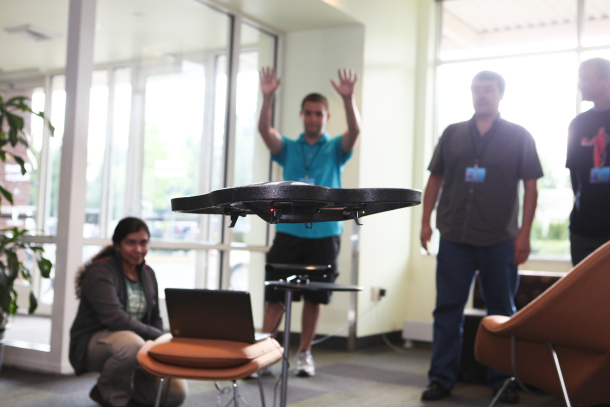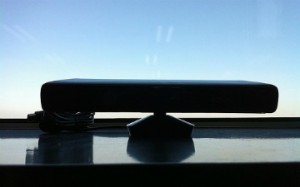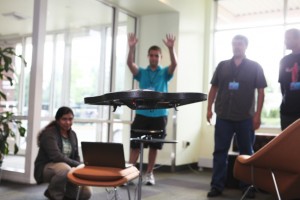After a few months of development, Microsoft released the Kinect for Windows software development kit, a tool for programmers to create applications for PCs that use the motion-sensing video game controller.
The free SDK is a beta product, and developers can only use it to create noncommercial applications. But there’s little doubt that it moves computing a small step closer to an era of natural user interfaces, where users can tell computers what to do with voices and gestures.
“This SDK really helps people move toward that,” says Anoop Gupta, an executive who holds the title of distinguished scientist in Microsoft Research who is overseeing the project. “We will see a world where computing becomes much more natural and intuitive.”

Oregon State University student Alex Wiggins gestures to Kinect, which in turn makes a remote-control toy helicopter take off while teammates Ruma Paul (left) and Fabio Matsui (right) look on. (Credit: Microsoft)
The SDK works with Windows 7 and lets developers get access to raw data coming from a depth sensor, a color camera sensor, and a four-element microphone array. The SDK can track skeleton images of one or two people, enabling gesture-driven apps. And it offers developers the ability to use noise suppression and echo cancellation, as well as beam formation, to identify sound sources and integrate with the Windows speech recognition programming interface.
Gupta expects those capabilities to unleash developer creativity and gin up a bevy of new apps for PCs. The company invited teams from several universities, including the Massachusetts Institute of Technology, the University of Washington, and Oregon State University, to its Redmond campus yesterday for a “code camp” to see what programs they could create in 24 hours.
“They’ve been suitably provided food and caffeine,” Gupta said.
One group created an application in which a user can conduct a virtual orchestra with gestures and voice. Another group produced an application that gives users the ability to manipulate a helicopter drone with gestures and voice.
Eventually, though, the company envisions a host of commercial applications, everything from a “Minority Report”-like technology that lets surgeons swipe through patient records without having to remove surgical gloves to a feature that lets executives move through presentations with hand gestures, instead of a handheld clicker.
Those commercial applications, though, will have to wait. Microsoft intends to release a commercial version of the SDK, but it hasn’t said when that will happen. If developers embrace the technology, the financial potential for Microsoft could be significant. It’s one reason why Microsoft put Gupta, who built and led Microsoft’s Unified Communications Group, on the task.
The ability to create these programs wouldn’t exist had Microsoft not released the Kinect to the gaming world first. Microsoft has sold more than 10 million of the $150 motion-sensing controllers to video gamers since it was release last holiday season. Selling that many Kinects enabled Microsoft to produce the device relatively cheaply, giving it the opportunity to bootstrap the business on PCs.
“Scale matters in terms of how much you bring down costs,” Gupta says. “It’s a $150 sensor. It’s an extremely low-cost way to get to some revolutionary ideas.”
Microsoft announced plans to offer the SDK at its MIX11 conference in Las Vegas in April, highlighting it’s efforts by jury-rigging a lounge chair with wheels, wiring, and a Kinect that lets loungers “drive” the chair with hand gestures. It only did so after the hackers came up with several creative, if unauthorized, programs using the Kinect. Now the company is hoping the vast collection of Windows developers will give it a shot.
Source


 Follow
Follow
